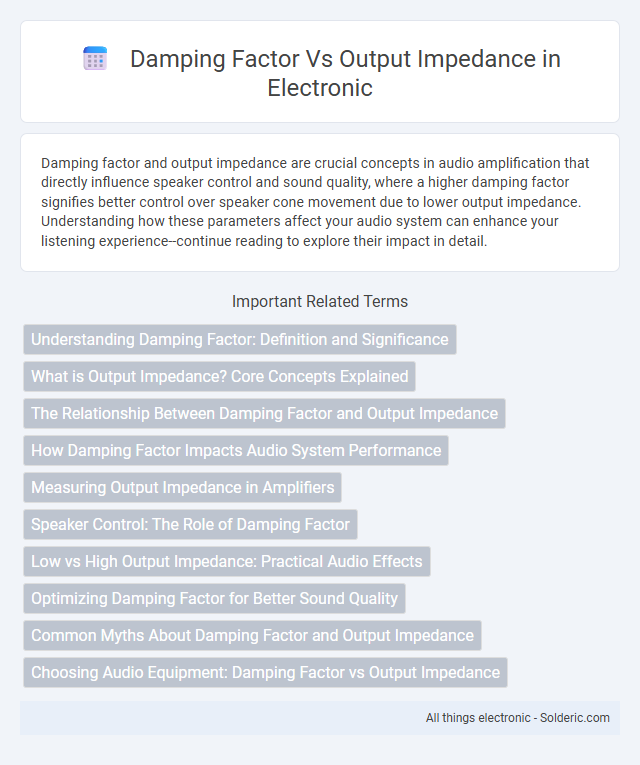Damping factor and output impedance are crucial concepts in audio amplification that directly influence speaker control and sound quality, where a higher damping factor signifies better control over speaker cone movement due to lower output impedance. Understanding how these parameters affect your audio system can enhance your listening experience--continue reading to explore their impact in detail.
Comparison Table
| Aspect | Damping Factor | Output Impedance |
|---|---|---|
| Definition | Ratio of speaker impedance to amplifier output impedance | Amplifier's internal resistance at output terminals |
| Formula | Damping Factor = Speaker Impedance / Output Impedance | Measured in ohms (O) |
| Typical Range | 20 to 1000+ | 0.01 O to several ohms |
| Impact on Audio | Controls speaker cone movement for tight bass response | Affects power delivery and control over the speaker |
| Importance | Higher values improve amplifier's control of speaker | Lower values reduce power loss and distortion |
| Measurement | Calculated from speaker and amplifier specification | Measured directly with specialized equipment |
Understanding Damping Factor: Definition and Significance
Damping factor is the ratio of a speaker's nominal impedance to the amplifier's output impedance, reflecting the amplifier's ability to control speaker cone motion. A higher damping factor indicates better control over the speaker, resulting in reduced distortion and improved sound clarity. Understanding damping factor helps you choose amplifiers that ensure accurate audio reproduction by minimizing unwanted speaker resonance.
What is Output Impedance? Core Concepts Explained
Output impedance is the measure of the resistance a device, such as an amplifier, presents to its connected load, significantly affecting how efficiently power is transferred to speakers. Lower output impedance allows better control over speaker motion, resulting in clearer sound and reduced distortion, which directly improves the damping factor. Understanding output impedance is crucial for optimizing audio performance, as it influences the interaction between amplifier and speaker, impacting overall sound quality and system stability.
The Relationship Between Damping Factor and Output Impedance
The damping factor is the ratio of a speaker's nominal impedance to an amplifier's output impedance, directly influencing speaker control and sound quality. A higher damping factor indicates lower output impedance, resulting in better control over speaker cone movement and reduced distortion. Precise matching of output impedance with speaker impedance is crucial for achieving optimal damping performance and audio fidelity.
How Damping Factor Impacts Audio System Performance
Damping factor, defined as the ratio of the amplifier's output impedance to the speaker's impedance, critically influences audio system performance by controlling speaker cone movement and reducing distortion. A higher damping factor results in tighter bass response and improved transient accuracy, minimizing unwanted resonances and enhancing overall sound clarity. Conversely, low damping factors can cause looser bass and degraded audio precision, negatively impacting listener experience.
Measuring Output Impedance in Amplifiers
Measuring output impedance in amplifiers involves injecting a small test signal into the output and observing the voltage drop or current change to calculate the impedance. A low output impedance is crucial for maintaining high damping factor, ensuring effective control over speaker movement and reducing distortion. Accurate output impedance measurement helps optimize amplifier performance and sound quality by closely matching the amplifier to the speaker load.
Speaker Control: The Role of Damping Factor
Damping factor significantly influences speaker control by determining how effectively an amplifier can manage a speaker's cone movement. A higher damping factor, calculated as the ratio of amplifier output impedance to speaker impedance, ensures tighter control over unwanted cone motion, reducing distortion and improving audio precision. Low output impedance in amplifiers paired with appropriate speaker impedance enhances this control, resulting in clearer, more accurate sound reproduction.
Low vs High Output Impedance: Practical Audio Effects
Low output impedance results in a high damping factor, which improves speaker control by minimizing cone overshoot and distortion, producing clearer and tighter bass response. High output impedance leads to a low damping factor, causing less control over speaker motion and potentially resulting in muddier, boomy sound characteristics. You can optimize your audio system's performance by selecting amplifiers with low output impedance to achieve precise and high-fidelity sound reproduction.
Optimizing Damping Factor for Better Sound Quality
Optimizing the damping factor enhances sound quality by improving speaker control and reducing distortion; a higher damping factor indicates lower output impedance, allowing precise regulation of speaker cone movements. Output impedance directly affects the amplifier's ability to dampen resonance, with a lower output impedance resulting in tighter bass response and clearer audio reproduction. Balancing the damping factor and output impedance is crucial for achieving accurate, dynamic sound performance in audio systems.
Common Myths About Damping Factor and Output Impedance
Common myths about damping factor and output impedance include the belief that a higher damping factor always results in better sound quality, which is not necessarily true as the actual output impedance and speaker characteristics play a more critical role. Many assume that output impedance should be as close to zero as possible; however, a small, controlled output impedance can interact beneficially with speaker impedance curves to improve frequency response. Understanding that damping factor is a ratio derived from output impedance and speaker impedance helps clarify why it is not an absolute measure of amplifier performance, ensuring your audio system's design balances both parameters effectively.
Choosing Audio Equipment: Damping Factor vs Output Impedance
When choosing audio equipment, a high damping factor indicates better control of the speaker by the amplifier, resulting in tighter bass and reduced distortion. The damping factor is calculated as the ratio of speaker impedance to amplifier output impedance, so lower output impedance leads to a higher damping factor, improving audio performance. Selecting an amplifier with output impedance significantly lower than the speaker's impedance ensures optimal damping factor and superior sound clarity.
Damping factor vs Output impedance Infographic

 solderic.com
solderic.com